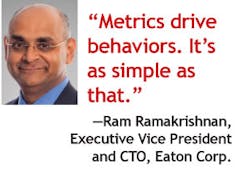We've all heard the innovation shtick a thousand times: innovation isn't about strategy; it's about people. It's about environment and interaction. It's about behaviors.
And as such, it seems that innovation, and all that strange magic R&D departments conjure, should be necessarily immune from the "quantify-everything" push in this age of Big Data.
Innovation, like any qualitative, behavior-driven endeavor, can be many things and can take on many forms -- the weirder the better sometimes -- but it can never be reduced to a simple numbers game.
Well, maybe not never.
In fact, to Ram Ramakrishnan, executive vice president, CTO and general innovation champion at Eaton Corp. (IW 1000/290), numbers, and specifically metrics, have become the go-to tool for building the innovative environment that keeps the company moving.
"Metrics drive behaviors," he explains. "It's as simple as that."
Like most data-driven industries, at Eaton, metrics are directly tied in with the company's recognition and reward program. So, meet your metrics, prove your worth. Or, from Ramakrishnan's point of view, embrace the behaviors that result in the desired numbers and you will add value to the company.
And to Ramakrishnan, that strategy is as sound in R&D as it is, say, on the plant floor.
From that perspective, innovation sounds easy. Brainless, even. Want an innovative culture? Just require monthly creativity quotas. Done.
But it's not quite that simple.
Wrong Metrics, Wrong Behaviors
It's not just a question of metrics in general that define a good company.
"You need to have the right metrics," Ramakrishnan says. "Right metrics, right behaviors. Wrong metrics, wrong behaviors." As an example, he points to one often-tried and often-failed innovation strategy: using patent applications as a proxy for creativity. "If done right, this can be a very positive strategy and have a positive output impact for our customers and Eaton," he says. However, he adds, "if you don't have the right portfolio going in and they still insist on having a rich portfolio of patents, then we could end up generating patents that are of absolutely no interest to our customers or Eaton."Require patents for bonuses and you'll get patents. But chances are they won't do anyone any good.
To avoid that, he says, you need the usual ingredients for success (the right people in the right place using the right tools, etc.), but, more importantly, it requires vigilance and careful control from senior leadership to keep good metrics from turning bad.
At Eaton, that means Ramakrishnan and a powerful group of engineering leaders, executive vice presidents, sector heads, marketers and business leaders meeting regularly to monitor, inspect and adjust the critical metrics throughout the organization to ensure that they are creating the right sets of behaviors.
"At the end of the day, processes around metrics to manage innovation effectively is a good thing," he explains. "But, the precept here is, if we don't have the right environment which fosters and facilitates innovation with the right people who can thrive in an innovative environment and who can be guided by the right processes and process-related metrics, then you will not drive the right behaviors."
Opening Innovation
The best example of this in action, Ramakrishnan says, is in his efforts to break the traditional silos at Eaton and create an environment of open innovation.
"The notion is very simple," he says. "Eaton has some very smart people, but so does the rest of the world. We need to tap into that external ecosystem, all the smarts of the external world."
Those smarts, he explains, can be found anywhere – universities, national labs, third-party technology parties, even the DoD. It can come from anyone who can help his company "co-innovate, co-invent some parts of technologies that we can then wrap into our total solutions for our customers."
The problem, of course, is that doing so runs contrary to the basic notion of R&D and the kind of proprietary research that has been core to such institutions for decades. R&D, he says, is still plagued with a bad case of "not invented here, or NIH, syndrome." And that is a hard thing to cure.
To overcome it, Ramakrishnan and his team hit the researchers where it counts: money.
"We set a goal to have a certain portion of the money of the total R&D portfolio come from external agencies, so they invest in us," he explains. "And on the flipside, there is also a portion of money that I would like to see invested in external parties."
Together, those two goals, plus the financial awards and recognitions he doles out for meeting them, fosters a new set of behaviors in the lab.
The metrics demand a certain level of partnership and openness while also rewarding practical application of it.
And that, Ramakrishnan says, does much more than inspire innovation. It inspires a culture of innovation.
"Fundamentally, innovation means being sure that we have the right environment that fosters innovation creatively," he says. "Creating that requires strategy and oversight from my office down."





